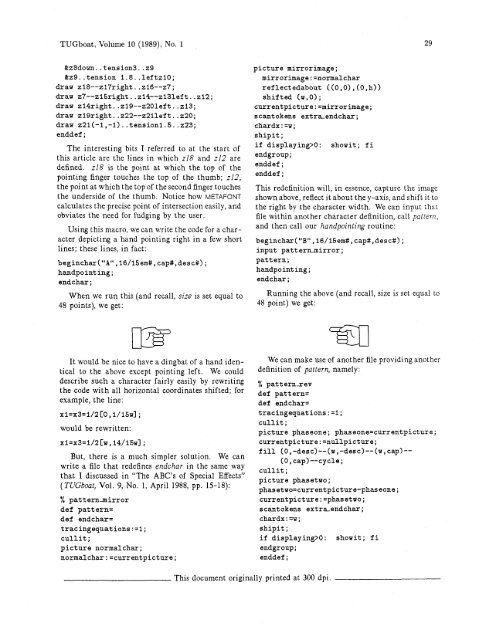Complete issue 10:1 as one pdf - TUG
Complete issue 10:1 as one pdf - TUG
Complete issue 10:1 as one pdf - TUG
You also want an ePaper? Increase the reach of your titles
YUMPU automatically turns print PDFs into web optimized ePapers that Google loves.
<strong>TUG</strong>boat, Volume <strong>10</strong> (1989), No. 1<br />
&z8down..tension3..z9<br />
&zg..tension 1.8..leftzlO;<br />
draw zi8--zl7right..zl6--~7;<br />
draw z7--zl5right..zl4--zl31eft..zl2;<br />
draw z14right..z19--~201eft..zI3;<br />
draw zi9right..z22--~211eft..z20;<br />
draw z21(-1,-l)..tension1.5..~23;<br />
enddef ;<br />
The interesting bits I referred to at the start of<br />
this article are the lines in which z18 and 212 are<br />
defined. zI8 is the point at which the top of the<br />
pointing finger touches the top of the thumb; z12,<br />
the point at which the top of the second finger touches<br />
the underside of the thumb. Notice how METAFONT<br />
calculates the precise point of intersection e<strong>as</strong>ily, and<br />
obviates the need for fudging by the user.<br />
Using this macro, we can write the code for a character<br />
depicting a hand pointing right in a few short<br />
lines; these lines, in fact:<br />
beginchar("AW ,16/15em#, cap#,desct) ;<br />
handpoint ing ;<br />
endchar ;<br />
When we run this (and recall, size is set equal to<br />
48 points), we get:<br />
picture mirrorimage;<br />
mirrorimage:=normalchar<br />
ref lectedabout ((0,O) , (0 ,h))<br />
shifted (w,O);<br />
currentpicture:=mirrorimage;<br />
scantokens extraendchar;<br />
chardx:=w;<br />
shipit;<br />
if display ing>0 : showit ; f i<br />
endgroup;<br />
enddef ;<br />
enddef ;<br />
This redefinition will, in essence, capture the image<br />
shown above, reflect it about the y-axis, and shift it to<br />
the right by the character width. We can inuut that<br />
file within another character definition, call pattern,<br />
and then call our handpointing routine:<br />
beginchar("B" , l6/i5em#, cap#,desc#) ;<br />
input patt ernmirror;<br />
pattern;<br />
handpointing ;<br />
endchar ;<br />
Running the above (and recall, size is set equal to<br />
48 point) we get:<br />
It would be nice to have a dingbat of a hand identical<br />
to the above except pointing left. We could<br />
describe such a character fairly e<strong>as</strong>ily by rewriting<br />
the code with all horizontal coordinates shifted; for<br />
example, the line:<br />
~1=~3=1/2 CO, 1/15wl;<br />
would be rewritten:<br />
xi=x3=1/2 Cw, 14/1Swl;<br />
But, there is a much simpler solution. We can<br />
write a file that redefines endchar in the same way<br />
that I discussed in "The ABC's of Special Effects"<br />
( <strong>TUG</strong>boat, Vol. 9, No. 1, April 1988, pp. 15-18):<br />
% patternmirror<br />
def pattern=<br />
def endchar=<br />
tracingequations :=I ;<br />
cullit ;<br />
picture normalchar ;<br />
normalchar : =currentpicture ;<br />
We can make use of another file providing another<br />
definition of pattern, namely:<br />
% patternlev<br />
def pattern=<br />
def endchar=<br />
tracingequations:=l;<br />
cullit ;<br />
picture ph<strong>as</strong>eona; ph<strong>as</strong>e<strong>one</strong>=currentpicture;<br />
currentpicture:=nullpicture;<br />
fill (0 ,-desc)--(a ,-desc)--(w , cap)--<br />
(0,cap)--cycle;<br />
cullit ;<br />
picture ph<strong>as</strong>etwo;<br />
ph<strong>as</strong>etwo=currentpicture-ph<strong>as</strong>e<strong>one</strong>;<br />
currentpicture:=ph<strong>as</strong>etwo;<br />
scantokens extr~endchar;<br />
chardx:=w;<br />
shipit;<br />
if displaying>O: showit; fi<br />
endgroup;<br />
enddef ;<br />
This document originally printed at 300 dpi.

















